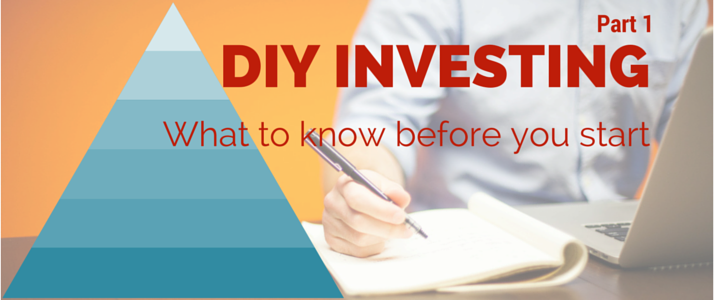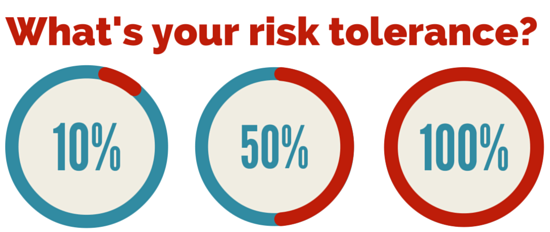
Do-it-yourself or DIY investing has never been easier. If you have access to the internet and aren’t afraid of technology, then you’ve got a chance to earn money on your savings like the 1% (buzz word for the super wealthy). In this multi-part series I’m going to show you how to invest in stocks, bonds, and index funds the easy way so that you can get your money earning more money. Here’s what you need to know before you start DIY investing.
1. Get debt free (except your mortgage)
First of all, you need to be out of debt except for a possible mortgage on your house. If you have any debt (credit card, personal loans, student loans), you need to take the money you’ve saved and pay that off first. It’s a guaranteed return on your money. What does that mean? If your credit card interest rate is 14.99%, whatever you pay off on that card, you’re essentially earning 14.99% back by not having to pay that interest. Debt is negative interest on your money. Paying it off is a guaranteed return. Even a 4% guaranteed return is better than trying to cover that debt by earning more in the market. Pay off your debts first.
2. Set up an emergency fund
Secondly, after you pay off your debts you want to have an emergency fund (EF) set up in a simple savings account. Many people encourage starting with a small emergency fund before you pay off your debts. This is a good idea. $1,000 is the accepted number. When you’re debt free, you want to build that small EF up.
How much should you have in your EF? Most people tend to recommend 3-6 months of living expenses (not income… expenses). This will cover most common car troubles, a serious accident, minor hospital bills, and most importantly a loss of a job. “Shawn – I’m an Ivy grad, my job is secure.” Yeah? Tell that to my Princeton buddy and Harvard friends who all got laid off in the financial crisis of 2009. Yeah, they were confident they’d get reemployed when the dust settled and they did. But that 3 month EF let them weather the storm much more easily than the idiots with fancy cars they couldn’t sell and huge apartments they couldn’t afford. From riches to rags without the EF.
So how much money do you need to live each month? I mean really need to live. Multiple that number by 3 and that’s your bare minimum. Emergency Fund example:
$2,100/mo bare minimum living expenses x 3 months = $6,300 EF
3. Invest for the long-term
Next, I’m assuming that you’ve saved some extra money outside of your EF and that you’re looking to invest for the long-term. I define short-term as less than 5 years . Intermediate-term is 5-10 years. And long-term is longer than 10 years.
| Short-term | Intermediate-term | Long-term |
| < 5 years | 5-10 years | 10+ years |
| Savings account | Robo-advisor | Index funds |
| CapitalOne 360 or Ally Bank | Axos Invest or Betterment | Vanguard (VTSAX) or TDAmeritrade (VTI) |
I’m assuming that you either have a longer time horizon before you plan to use this money and/or that you have a higher risk-tolerance than average (but not high enough to bet it all on black). You probably won’t retire for another 15 years or more. You could be 35 years old and hoping to retire on this money when you’re 65 (30 years from now). Or you could be 55 years old and planning to work until you’re 70 (15 years from now). Or you could be 25 and hoping to build your own perfect house when you’re 40 (15 years from now). Any of those fit the longer time horizon.
4. Know your risk-tolerance

As for risk-tolerance, I want you to know that your money sitting in a savings account is actually losing money to inflation. You want to invest in stocks. It’s better to get into the market and do it the smart way. You don’t really like the idea of bonds because let’s be honest, bonds return less than stocks. But you’re also afraid of investing in only a couple of stocks and losing a bunch of your hard earned money. I’m with you. Let’s invest the easy way: safer than individual stocks, but more aggressive than savings accounts and bonds.
Checklist
Are you ready to DIY invest?
- Are you out of debt except for your house (ie. mortgage)? If yes…
- Do you have an emergency fund of 3 months of expenses? If yes…
- Do you plan to invest this money for at least 3 years? If yes…
- Are you ready to earn more than in a savings account? Of course you are…
If you answered like a wealthy person, then you’re ready to DIY invest the easy way to earn more money. In the next article, we’re going to take a look at what we’re going to invest in and why. Nope, I’m not going to try to sell you on penny stocks, or the next hot bio-tech. We’re keeping it simple and I’m going to teach you how to DIY invest the smart way. It’s index funds all day long baby.